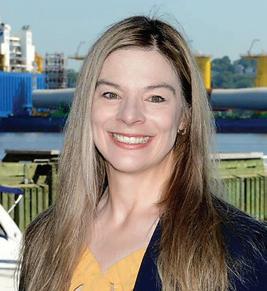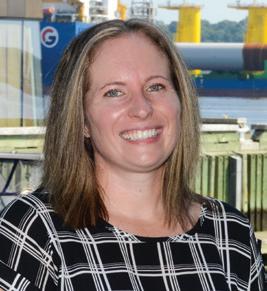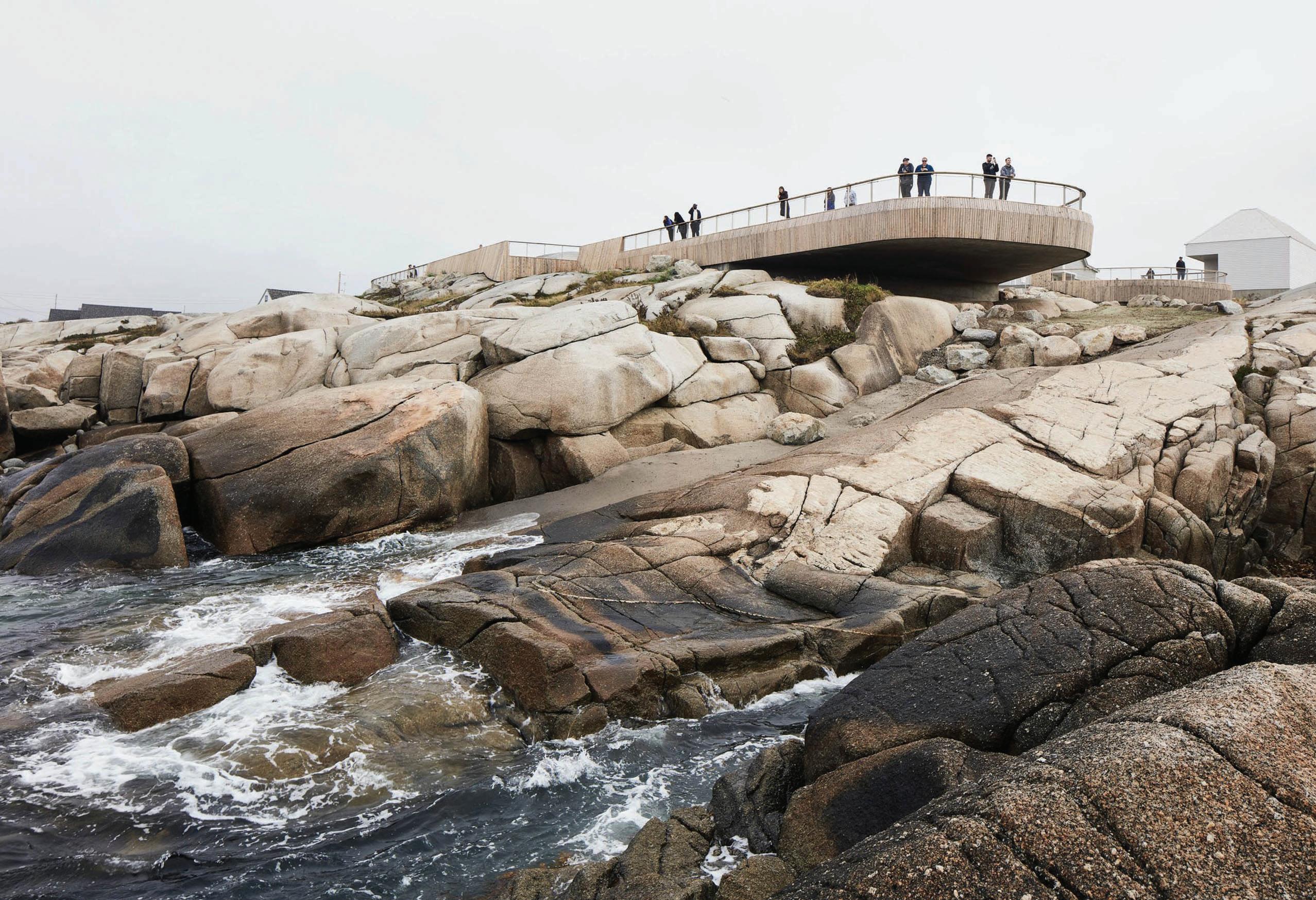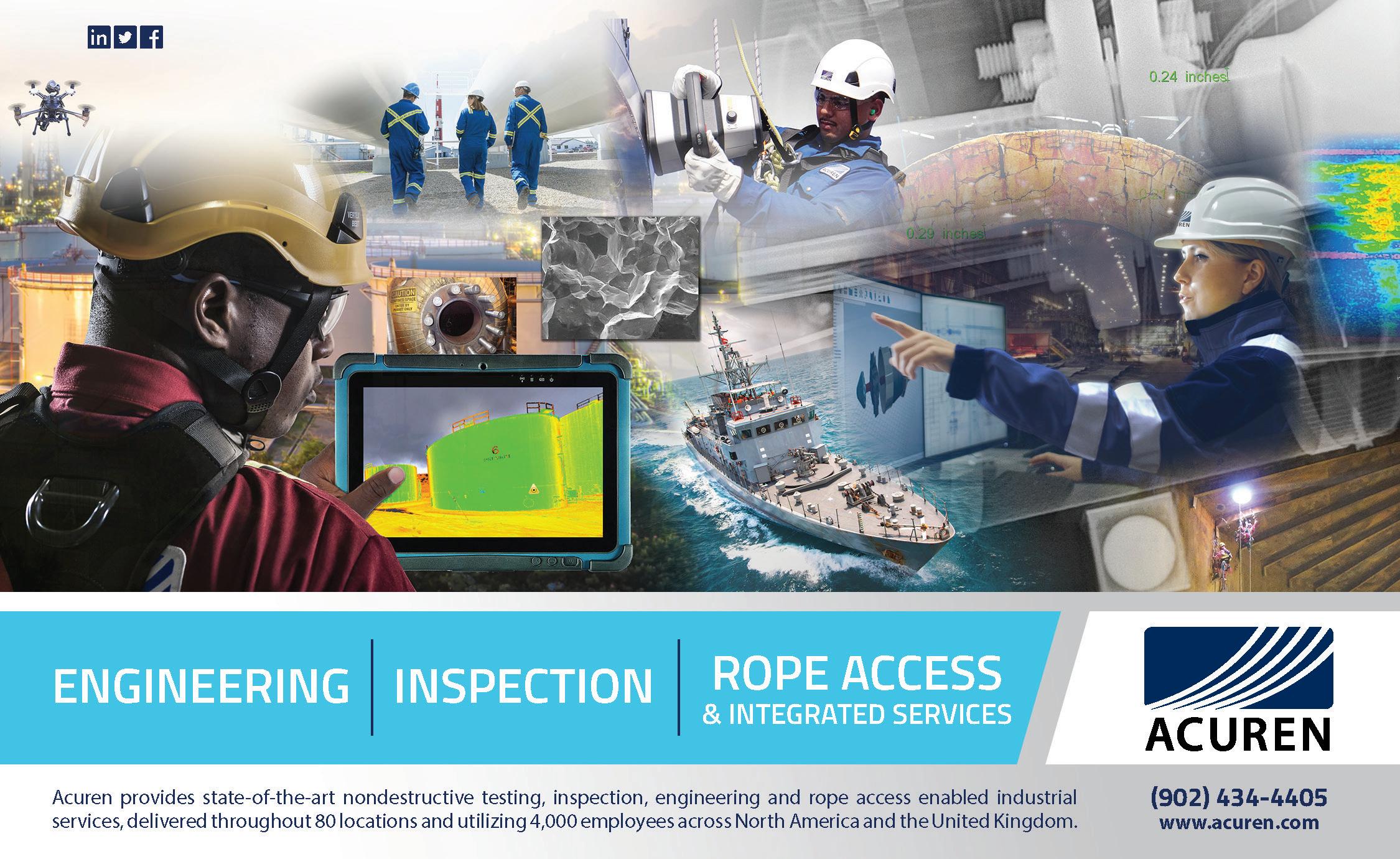
Profile: Wisdom Akpokighe










Profile: Wisdom Akpokighe










As we embark on the second year of executing our five-year strategic plan, we continue to watch the national regulatory landscape, noting the regulatory changes that are taking place across Canada.
Alongside other professions, engineering regulators are facing a number of changes and challenges, such as defining the appropriate balance between regulation and advocacy, complying with fair registration practices, responding to challenges on the use of title, and defining expectations related to emerging technologies, to climate change, to diversity and to truth and reconciliation. Alongside all these issues, engineering regulators are also initiating programs to support the long-term health of the profession.
Many of these changes and challenges are moving us beyond the traditional regulatory activities of registration, practice standards, and enforcement and into a new area of activity that is still undefined-an area we are calling “professional sustainment.” For us, professional sustainment focuses on a healthy profession that allows the long-term provision of competent and ethical professional engineering services to Nova Scotians.
In this new environment, Engineers Nova Scotia will be tested as it meets the demands of fulfilling both mandated tasks and professional sustainment tasks given the resources available internally.
We have often shared our thoughts on the social licence to practice and professional regulation-how we maintain the public’s trust in engineers through effective professional regulation of engineers by engineers. This model is founded on the principle that we will continue to benefit from the participation of our registrants, who provide the guidance and support that shapes our culture.
Engineers Nova Scotia is well positioned to meet its legislated task, which is underscored by our mission statement, “… we license registrants who are qualified and competent, assisting them to fulfill their obligations to practice engineering in the best interests of the public...”
However, our vision to be an accessible, progressive and trusted regulator of the engineering profession can result in expectations that exceed the Association’s staff and volunteer capacity. Meeting these expectations requires the energy and effort of all our registrants to undertake the professional sustainment
activities that support each other and the health of our profession.
You may ask, “What can I do to support professional sustainment and my engineering peers?”
Simply put, it is by becoming an advocate for other engineers and for the health of our profession.
To become an advocate, there are things we can all do to without relying on the Association to guide us. These include:
Mentoring and Coaching: Experienced engineers can act as mentors or coaches to guide and support less experienced engineers, engineers-in-training, and engineering students. They share their knowledge, they offer advice and they help others develop their skills and expertise.
Sharing Knowledge: Engineers often have specialized knowledge in their respective fields. Sharing this knowledge with others can improve the overall competence and effectiveness of the team or organization.
Promoting a Learning Culture: Encouraging continuous learning and professional development is crucial to maintaining competency and protecting our social licence to practice. Engineers can organize workshops, seminars or training sessions to share knowledge and skills with their colleagues.
Building a Supportive Network: Creating a supportive network is beneficial for everyone. Engineers can help establish connections and facilitate communication between team members and other engineers, allowing others to expand their networks.
Celebrating Success: As engineers, we should celebrate success and show appreciation for our peers’ accomplishments, through awards programs or by
showcasing their efforts in publications.
Supporting the Community: By getting involved, Engineers can strengthen their communities. Leveraging our education and experience, we can offer a variety of skills and perspectives that can assist boards, councils and other organizations. By volunteering at STEM events at elementary and high schools, or with other youth organizations, you can play a role in building the interest and motivation that could support the health of our profession in the years to come.
These actions focus on fostering a culture of collaboration, of learning, and of mutual respect, which strengthens our engineering community and public trust. While Engineers Nova Scotia can play a role in guiding and advising committees and volunteers, every engineer and engineer-in-training can support professional sustainment, our 8,500 registrants, and all the aspiring engineers in Nova Scotia.
In this busy world, we face many demands. However, if we are to remain a strong, vibrant, relevant profession, each of us can consider what we can do – particularly in those areas that fall outside Engineers Nova Scotia’s well-defined regulatory mandate. We all have the power to positively influence the sustainment of our profession leading to a safe and sustainable Nova Scotia protected by accessible, progressive, and trusted regulation of the engineering profession.
Denise Pothier, P.Eng., MBA, FEC
Pal Mann, CD, FCSSE, P.Eng., ICD.D.
The Association of Professional Engineers of Nova Scotia
Engineers Nova Scotia Council 2022-2023
Denise Pothier, P.Eng.
Dr. Adam Donaldson, P.Eng.
Darrin McLean, P.Eng.
Alexander de Sousa, P.Eng.
Kelsey Green, P.Eng.
Jennifer MacDonald, P.Eng.
Wayne MacDonald, P.Eng.
Dr. Allison Mackie, P.Eng.
Leon MacLellan, P.Eng.
Roxanne Tate, P.Eng.
Laura White, P.Eng.
Ex-Officio Members
DS (Pal) Mann, P.Eng.
Crysta Cumming , P.Eng.
Dr. John Newhook, P.Eng.
Zone Representatives
Darrin McLean, P.Eng.
Oliver Browning, P.Eng.
Vivek Tomar, P.Eng.
Conrad LeLièvre, P.Eng.
Ron Marks, P.Eng.
Andrew Polegato, P.Eng.
Harry Daemen, P.Eng.
Committee Chair Persons
Browren Allard, P.Eng.
Kulvinder Dhillon, P.Eng.
Craig Lake, P.Eng.
Debra McLellan, P.Eng.
George Goad, P.Eng.
Holly Sampson, P.Eng.
Jennie Rand, P.Eng.
James Beck, P.Eng.
Lawrence Murphy, P.Eng.
Jeff Knapp, P.Eng.
Christine Bonnell-Eisnor, P.Eng.
Darrell Marsh, P.Eng.
Stephanie Beaton, P.Eng.
President Vice-President
Past-President
Councillor
Councillor
Councillor
Councillor
Councillor
Councillor
Councillor
Councillor
CEO & Registrar Engineers Canada Director
Dean, Faculty of Engineering
Professor, Civil and Resource
Engineering, Dalhousie University
Cape Breton/Victoria Colchester
Halifax/Hants
Kings/Annapolis
Pictou
Cumberland
Antigonish/Guysborough
Professional Practice
Honours & Awards
Board of Examiners
Complaints
Disipline
Continuing Professional Development
Women in Engineering Safety
Sustainability
Finance & Audit
Student Affairs
National Engineering Month
Emerging Professionals

The Professional Practice Committee (PPC) has been assessing the current definitions of as-built and record drawings, and researching the definitions in place at other engineering regulators and used in industry. A Sub-Committee was assembled to conduct a full review and to make recommendations to the PPC for modernizing these terms, with the goal of aligning them with practice and industry standards.
The new definitions (shown below) will soon be updated in the Guideline on the Use of the Professional Stamp, which is the most widely referenced Guideline used by Engineers Nova Scotia registrants. To view the most up-to-date Guidelines, visit our website at engineersnovascotia.ca/professional-practice/ engineering-practice-guidelines/
Drawings referred to as as-built are prepared by a third party, or by the engineer using information provided by a third party. As-builts are meant to reflect the actual installed, fabricated,
constructed or commissioned condition of an item or project. Some of the information provided on as-built drawings might be changes authorized by the engineer during construction, while other information might reflect changes initiated by other parties due to site conditions or other causes. The engineer does not typically accept professional responsibility for as-built drawings.
Record drawings are prepared by an engineer to record design changes for which they accept professional responsibility. The engineer may have issued the changes and authenticated them previously through change orders, change directives, or site instructions. The changes are then incorporated into one final drawing set along with the original design elements. Since the engineer is professionally responsible for the record drawings, they must stamp the drawings to comply with the Engineering Profession Act.

The PPC is working with staff to finalize a consultation process to gather feedback on several new Guidelines that are currently being finalized. Additional information will be provided when this consultation process is ready to be implemented.
As reported in the last issue of The Engineer, the Chief Executive Officers of the Atlantic engineering regulators met on several occasions to discuss the harmonization of Continuing Professional Development (CPD) program requirements for registrants of the Professional Engineers and Geoscientists Newfoundland and Labrador, Association of Professional Engineers and Geoscientists New Brunswick, Engineers PEI and Engineers Nova Scotia.
A document summarizing the potential harmonized requirements has been reviewed by the CPD Committee, and will be discussed by Council at a meeting in the Fall, prior to consultation with registrants. Some of the areas where CPD programs have changed across Canada, include:
• Removal of Professional Practice hours (50 PDH/yr)
• Reduction in overall PDH’s (generally from 80/yr down to 30/yr)
• Less categories for CPD and standard 1 hr/1 PDH basis
• Mandatory categories, such as ethics and regulatory knowledge, with webinars created to facilitate learning in these areas
• Reporting and auditing of CPD activities
Before any changes are made to the existing CPD program for Engineers Nova Scotia, a full assessment of the impacts and benefits to registrants will be conducted as part of the consultation activities.



The Coastal Protection Act (CPA) was established by the Nova Scotia government to help protect natural ecosystems. Over the past several years, Engineers Nova Scotia has provided feedback to the Department of Environment and Climate Change (ECC), outlining areas of concern and other additional information as part of the consultation process.
As of the end of July 2023, the government has indicated they will be commencing an additional consultation with property owners and other stakeholders before the CPA comes into force. The Regulations and other supporting tools and processes must also be finalized.
Engineers Nova Scotia will continue to provide feedback to ECC as part of the consultation process. The most updated information on the Coastal Protection Act can be found on our website at engineersnovascotia.ca/ professional-practice/coastal/
There have been numerous emails and phone calls from both engineers and members of the public, asking about completing a CPA assessment on a property. Until the CPA comes into effect, there is no formal assessment that can be completed, but some municipalities may have by-law requirements for an assessment or review of properties in regard to coastal flooding potential.
Engineers Canada is the National organization that works on behalf of the provincial and territorial associations that regulate engineering practice and license the country’s 300,000 members of the engineering profession. One of the more recent areas of focus of Engineers Canada has been in the creation of National Position Statements (NPS), which are consensus positions of the provincial and territorial engineering regulators on key issues that relate to the public interest. These statements serve not only to inform members of the engineering profession about key issues but are also meant to facilitate discussion with government and influence public policy.
Engineers Nova Scotia provides feedback and subject matter expert advice when a new NPS is developed, through staff based groups like the National Officials Groups, from feedback by the CEO’s of the engineering regulators and through volunteer Committees like the Professional Practice Committee.
Recent NPSs that have been created by Engineers Canada include:
• Artificial Intelligence Engineering Technology in Autonomous and Connected Vehicles
• Diversity, Equity, and Inclusion
• Federal Regulations of Small Fishing Vessel Design
• Infrastructure on Indigenous Reserves and in Remote Indigenous Communities
For a full list of the NPSs, visit the Engineers Canada website: engineerscanada.ca/public-policy/ national-position-statements
If you have any questions about Professional Affairs, or would like clarification about the Engineering Profession Act or By-Laws, please contact me to discuss. And if you know of anyone who may be in violation of any of our areas of regulation, I would be glad to hear from you. I can be contacted at kdove@engineersnovascotia.ca.
After 26 years with Engineers Nova Scotia Virginia MacQuarrie, FEC (Hon), the Director of Finance and Administration, will retire in late August 2023. Virginia has led the Association’s financial management for the better part of three decades, including working with registrants to collect annual dues, coordinating payroll and volunteer expenses and handling all accounts payable and receivable. As the main point of contact for our annual financial audit, Virginia has provided support and access to our external auditors to test our financial system and internal controls.
Virginia has also been a passionate supporter of students and aspiring engineers, providing the staff support to both the Student Affairs Committee and National Engineering Month Committee - she has organized countless egg drop competitions for schools across the province. She has been a champion for students thinking about engineering as a career.
On behalf of Council, Staff, and our 8,500 registrants, we thank Virginia for her for longstanding dedication to Engineers Nova Scotia over the past 26 years, and wish her and her family continued happiness in their next chapters.





Pal
CEO & RegistrarAs a part of your regulatory body, it is my role to translate Council’s guidance into action, and to make sure that our volunteers and employees have the resources and time to complete their function successfully so we can fulfill our professional and ethical obligations.
Favourite spot in Nova Scotia: Annapolis Royal-a wonderful combination of yesterday, today and tomorrow. You can also get a great schnitzel and Weissbier!

Engineers Nova Scotia licenses qualified engineers and assists them in fulfilling their obligation to practice the profession in the public’s best interest. As a staff, we work to inform our registrants, educate the public, reinforce regulatory excellence and celebrate our province’s engineers.
Christine
Director, Communications and Information TechnologyThe Communications Deparment plays a key supporting role to Council, Staff, Committee Volunteers, Zone Representatives, Partners and Stakeholders. It is my role to manage and utilize technology to communicate, facilitate and support the strategic objectives and initiatives set by each group.
Favourite spot in Nova Scotia: Annapolis Valley-the farms, sea breeze, Acadian culture and history, the simplicity of being, soulful– feels like home!

Heidi Director, Outreach and Partnerships
I am responsible for raising public and member awareness of the Association’s purpose and roles, supporting professional sustainment, volunteer engagement, and enhancing member experience. I enjoy working with several Engineers Nova Scotia committees, to fulfill legislated tasks, and to identify and undertake initiatives that support the Association’s objectives.
Favourite spot in Nova Scotia: North End Halifax-it has many hidden gems.

Kris COO & Treasurer
I am fortunate to interact with registrants and the public to assist in clarifying the professional practice expectations for safe engineering in the best interest of the public.
Favourite spot in Nova Scotia: A back country campsite on a lake at Kejimkujik park with nothing but the sounds of water, owls and loons.

Charity Professional Practice Officer
I support the operation of the professional practice group by ensuring compliance with, and enforcement of, the Engineering Act, By-laws and Code of Ethics, developing policy and supporting our internal and national committees.
Favourite spot in Nova Scotia: The Annapolis Valley-having come from the Prairies, the beauty of farmland is very familiar, but also completely different with the dykes, orchards and vineyards.

Pavel Events Planner
I create memorable and unique event experiences. I help our registrants and stakeholders bring the engineering community together through learning and networking.
Favourite spot in Nova Scotia: Lunenburg-I love the representation of Nova Scotian flair and the iconic Bluenose II

Shanice
Director of Registration
My team and I get to see the heartbeat of the profession as we work with applicants throughout the registration process. We help their dreams of becoming engineers a reality.
Favourite spot in Nova Scotia: Anywhere with water and/or a view!

Nadine
Registration Coordinator
I am responsible for supporting all efforts of the Registration Department, with a focus on processing applications from individuals who are internationally educated.
Favourite spot in Nova Scotia: Cape Breton-summer vacations spent in River Bourgeois, Englishtown and Port Hood.

Ashley Registration Assistant
My focus in the Registration Department is to ensure engineers-in-training move through the Mentorship Program effectively.
Favourite spot in Nova Scotia: Cape Breton or anywhere by the ocean.

Brittany
Registration Assistant
My role is centered on confirming applicants’ National Technical Exams, National Professional Practice Exams and companies’ requirements.
Favourite spot in Nova Scotia: Anywhere spent with family and friends!

Chantal
Registration Assistant
I invoice applicants, build close relationships with them, ensure they understand the requirements and are confident in Engineers Nova Scotia’s support.
Favourite spot in Nova Scotia: Annapolis Valley, the South Shore and anywhere in between!

Lauren Communications Coordinator
I curate our various communications streams, including our social medias, e-newsletter and quarterly magazine, to inform and connect with registrants. I strive to highlight the engineering profession with written storytelling through voices in our community.
Favourite spot in Nova Scotia: Point Pleasant Park-it has the most adorable dog sightings.

Aaron Multimedia / Graphic Designer
I am updating our brand and the products our team uses in our work to inform registrants and bring them together at events. I design materials for print and digital, like the one you’re reading now.
Favourite spot in Nova Scotia: On a paddleboard on Shortt’s Lake, in a canoe on the Musquodoboit River, or a kayak in Blind Bay.

Impromptu networking of engineers at pilates
“It’s so nice we have the ring to signify our profession, it supports unity and can break down social barriers in any situation allowing engineers to form social connections with others.”
- Matthew Gynn, P.Eng.Pictured (left to right) Gabrielle Morrison, Kendal Baker and Matthew Glynn.
Engineers Nova Scotia congratulates Zoe Smith on receiving the 2023 Convocation Award. Zoe is a 2023 Chemical Engineering graduate and has recently finished serving as the President of DUES at Dal.
Recipients of the Convocation Award receive 4 years of paid Engineers-In-Training dues.



Dalhousie Agricultural Campus’ 50th Community Day
Community Day is an opportunity for community members to learn about modern farming through presentations of the university’s research activities and multidisciplinary programs. Through these educative methods and activities like wagon rides and live music, participants get a chance to see how engineering and other disciplines serve the agriculture field—all with a bit of fun involved!
Photo credit: Mandi Wilson. Photo taken in the Banting Building, home to the Engineering Department.
This was a fantastic evening with our new P.Eng.’s and their families and mentors, in celebration of their licensure. Welcome to the profession and your new role of guiding engineering students and engineers-in-training. Congratulations from Council and our 8500+ registrants.
Canadians to think about engineers in new ways

In the spring earlier this year, Engineers Canada launched their six-weeklong “Building Tomorrows” campaign. “Building Tomorrows” emphasizes the incredible difference engineers make in our world through a thirty-second television ad, a new microsite and social media content. The campaign strives to inform Canadians that engineers aren’t just building things; they are building solutions and hope for a brighter future. Created with collaborative efforts from Canada’s provincial and territorial bodies, including Engineers Nova Scotia, Engineers Canada’s “Building Tomorrows” campaign calls upon Canadians to broaden their perception of what an engineer is, and can be.
“We all know that engineers design things. But they don’t just design buildings or bridges. They solve problems. And make our lives better. Our new campaign ‘Building Tomorrows’ highlights the important contributions of engineers and the many ways they help to make our world a better place-from creating smarter cities to keep us safe to designing novel treatments that cure disease to harnessing renewable energy to fight climate change. Because that’s what engineers do. They build hope for a better world and a better future for us all.”
-Engineers Canada, April 11th, 2023
“This is an exciting opportunity for us to demonstrate who engineers are and the ways in which engineering disciplines are driving solutions to our shared challenges. It is also an important way to reflect the rich diversity of Canada’s engineers and the work they do across the country.”
– Gerard McDonald, MBA, P.Eng., ICD.D, and Chief Executive Officer of Engineers Canada


Through extensive research with opinion leaders, parents, students and employers, Engineers Canada determined that Canadians weren’t aware of the full scope of what engineers are capable of. Engineers are, in fact, capable of making a difference in the everyday lives of Canadians by providing solutions to pressing challenges including climate change, healthcare, urban planning and safe infrastructure. Not only are these challenges affecting Canadians, but they are also affecting the world at large.
A second launch of the “Building Tomorrows” campaign with new creative messaging will be released come Fall.

In May of 2023, Harbourside Engineering Group, in collaboration with Englobe Corporation, was named this year’s recipient of the Lieutenant Governor’s Award for Excellence in Engineering for their impressive work on public safety and climate change adaptation through the Peggy’s Cove Infrastructure Design Project.
Each year, a jury panel selected by Engineers Nova Scotia selects a standout team, company, government department or consortium of professional engineers who have achieved impressive creative feats in the application of engineering principles and professional standards, to be awarded the Lieutenant Governor’s Award for Excellence in Engineering. The name of the award is in recognition of J. J. Kinley, P. Eng., the first and only Engineers Nova Scotia registrant to hold the title of Lieutenant Governor of the province of Nova Scotia and only professional engineer to garner the position of Lieutenant Governor of any province in Canada. It was first presented in March of 1997, at Government House during National Engineering Week.
THE TEAM:
Harbourside Engineering: Transportation, Civil, Structural and Geotechnical Engineering, Stormwater Management
Englobe: Municipal Services, Mechanical/ Electrical Engineering
EDM Planning Services: Landscape Planning and Master Planning
Omar Gandhi Architect: Architecture
Upland Planning and Design: Landscape Architecture
“For the first time, Peggy’s Cove is accessible to all visitors. Everyone can experience the beauty of the area and enjoy viewing the lighthouse in person. The project also demonstrates respect to the spirit of the community and the surrounding landscape.”
-Lieutenant Governor of Nova Scotia | The Honourable Arthur J. LeBlanc, ONS, QC
 Photo © Maxime Brouillet
Photo © Maxime Brouillet
The Peggy’s Cove project is a prime example of a modern and significant engineering achievement which not only demonstrates economic benefit and highlights Nova Scotian leadership in the industry, but also enhances the overall image of the engineering profession. The project revitalizes an iconic Canadian site through infrastructure improvements to the viewing platform of the Lighthouse area, the Cove, as well as in public washrooms, the Visitor Information Center and parking management, without interfering with the community’s existing topography and
character. Each improvement is intended to encourage people to stay a little longer—to be able to sit and enjoy the coastal atmosphere.
Like any good engineering project, the Peggy’s Cove Infrastructure Design Project considers ideas to revisit and potential future pathways. A gate installed close to the road near the Visitor Information Centre to divert visitor traffic from the Lighthouse parking lot, and a shuttle service operating between the Visitor Information Centre and the Lighthouse, are two of these potentials.
As one of most photographed landmarks in Nova Scotia, this years’ Lieutenant Governor’s Award for Excellence in Engineering recipient is undoubtedly special.
“This project showcases the dedication, energy, knowledge and expertise that teams of professional engineers and engineers-in-training, supported by other professionals, bring forward to make the lives of Nova Scotians better,” said DS (Pal) Mann, CEO and Registrar, Engineers Nova Scotia. “It is a prime example of how professional engineers help build better tomorrows.”

“Climate change, sea level rise, and storm surges were identified as an increasing risk to Peggy’s Cove. The raising of the road and the reconstruction of the breakwater are measures to mitigate the impacts of climate change. A coastal study, including storm modeling and LiDAR data, helped to formulate the solutions and designs.”
- Build Nova Scotia, Peggy’s Cove Infrastructure Improvement Strategy
Breakwater Improvements: The new breakwater was constructed by stacking natural materials around and over the existing breakwater.

“The Cove is vulnerable to hurricanes and sea level rise. In the recent past, both Hurricane Juan (2003) and Hurricane Bill (2009) breached the community sea wall and flooded Peggy’s Point Road.”
- Develop Nova Scotia, Comprehensive Master Plan for Peggy’s Cove
Improvements to Peggy’s Point Road: A portion of the road was raised to help address climate change issues related to sea-level rise and storm surge inundation. DeGarthe Studio and the Buoy Shop were also raised.


It has become increasingly difficult— oftentimes, impossible—to tell the difference between human and robot-generated responses. With user-friendly Artificial Intelligence technologies like ChatGPT, communication with robots has become commonplace and arguably the new normal.
This type of cohesive cyber-relationship has not always been the case, however.
According to the Department Head of Industrial Engineering at Dalhousie University, Uday Venkatadri, P.Eng., the AI tools that existed in the 1990’s during his PhD at Purdue University were very mechanical and unhuman.
“There has been a ‘rebranding’ of AI in recent years in which all the concepts we used to see in the early days are now a reality,” he says. “Everything has gotten so much quicker and better.”
Venkatadri notes the major impacts to teaching and research given the widespread application of AI across an array of workplaces, including professional engineering.
“A lot of it is coming from the high degree of automation capabilities that AI machines have these days— things like self-driving cars, and automated mobile robots. I think from a teaching perspective, we need to make sure that our students can work within these new terms.”
Self-driving cars are an output of machine learning (ML), a branch of AI in which data-fed algorithms can mimic the way humans learn and predict outcomes. As the processing power of big data continues to expand, these human-built algorithms are only getting smarter, and more accurate.
In industrial engineering, for example, an AI robot can do some of what
Venkatadri deems the “nitty gritty stuff” such as providing a forecasting system for inventory, as opposed to a human physically flipping through a load of paperwork to complete a data analysis. Processes such as this can be automated so that an engineer can focus their energy on more specialized skills like design.
Alex Pottier, Dalhousie Industrial Engineering graduate and Program Manager for campus-based ocean tech company, DeepSense, adds to this sentiment. Managing the development of ML systems that respond to the needs of ocean-related companies in Atlantic Canada, Pottier has seen automation work firsthand.
Take a local fishery, for example. DeepSense could build a computer vision model to scan a fishing boat’s deck in real time to count and categorize the fish by species. The tedious cataloguing done by a human could be done almost instantaneously by AI technologies.
“AI is an extension of yourself and furthering what you already do,” says Pottier. “If you’re working with data or doing any kind of forecasting, it just gives you more power to do that. You can make much more informed decisions if you have that input next to your intuition.”
Pottier is confident that ML can significantly cut down the time an engineer spends on cognitive tasks.
“Think about if you’re working on a schedule or a routing problem; as an engineer, you already have a built-in knowledge on how such systems should work,” he says. “Using ML and AI, you can assemble something, and you can interpret it to see if its correct or not before, rather than spending time on developing such systems.”
That said, if we’re handing off some of the work to robots, there are an array of ethical concerns to consider. At the forefront of public discourse is that AI and ML are expected to replace humans in a variety of jobs, including different strains of engineering.
To this, Pottier advises people to take a step back before jumping to conclusions.
“I totally understand that concern and to some degree share it, but I think it’s a deferred concern to a time in the future when the capabilities are a lot more advanced than they are right now,” he says. “At the moment, it’s going to make people’s jobs easier and make dangerous jobs safer—it’s really up to the people working on it to implement it in a way that mitigates risk.”
A learning model is only as good as the person’s understanding of the system that trains it. This is why Pottier urges professional engineers to apply AI in a collaborative, gradual and thoughtful manner.
Health and safety within the profession should always be the number one priority, with AI or not. Venkatadri encourages engineers to work alongside AI to ensure safety, rather than against it out of fear and misunderstanding.
As for the future, things are not entirely clear. Both Venkatadri and Pottier acknowledge the evolving nature of AI, but they remain hopeful.
“I think that the genie is out of the bottle so now the biggest challenge is how we’re going to best make AI work for us and society,” says Venkatadri. “What’s exciting is that we have a new and more rapid way of learning, there’s no need to sit down and look at books anymore.”
Pottier has witnessed new learning methods in action— things like AI predicting water levels to elicit safer marine travel and forecast a comparison of greenhouse gas emissions between gas and electric-powered boats. All methods that are saving companies money and making the harbor a healthier place.
“I’m seeing things that human beings wouldn’t be capable of without AI.”

“Engineering is engineering anywhere in the world, Germany, England, Canada, Nigeria. There are just different codes, but the concept of design is exactly the same.”

Wisdom Akpokighe, P.Eng. currently a project manager with the Halifax Regional Municipality, exudes confidence and personality.
He began his life in Halifax six years ago, after leaving his home in Nigeria with fourteen years of experience as a civil engineer, and impressive academic

accomplishments, to find work that challenged him and managed largescale projects. Creating a safe and happy life for his wife, Bolanle, and their three young children was also a priority.
With the helpful professionals at the Immigrant Services Association of Nova Scotia (ISANS), Engineers Nova Scotia and the Halifax Partnership Connector Program, Wisdom has been able to accomplish these diverse goals.
After finding ISANS online and taking several of their online courses, the Assocation’s Internationally Educated Engineers Bridging Program helped Wisdom to create a flexible schedule which included several more courses, a survival job, a twelve-week placement and family orientation activities.
According to Samar Khalil, Coordinator of the ISANS IEE Bridging Program, the number one barrier for IEE’s to overcome is confidence. Prior to the establishment of the program in 2005, many talented and well-educated immigrants, keen on pursuing their engineering careers tended to lose their confidence once in their ‘survival jobs.’
Even with his background, passion, and intelligence, Wisdom agrees with this sentiment. “Confidence is shaken when people do not understand what you say due to your accent, or your way of expressing an idea. Some treat you differently because you do not look like them. Being knowledgeable about cultural differences, acquiring communication and other soft skills, are as important as technical knowledge in the Canadian workplace,” he says.
The ISANS’ Orientation and Communication Skills for Engineers (OCSE) Program enabled Wisdom to gain skills to navigate the new workplace and local community. ISANS’
Canada Connections program also paired Wisdom’s family with a local family to attend various events and local destinations, like museums and neighborhood walks.
It was his twelve-week placement with the Department of Public Works, then called the Department of Transportation and Infrastructural Renewal, that prepared Wisdom to apply for a position at SNC Lavalin. While attending a Halifax Partnership (HP) seminar, conducted by Gerald Walsh, of Gerald Walsh Associates Inc., Wisdom connected with Nathan Laird, coordinator of the HP Connector Program, who called on his behalf to set up an interview.
His subsequent experience working with CBCL Limited led to Wisdom’s current position with HRM. Wisdom now demonstrates his appreciation for the benefits of networking, and his gratitude to everyone who helped along the way, by volunteering with the HP Connector Program, where he was the recipient of the Connector of the Year award this year.
Through it all, Wisdom attributes his success to keeping his goals topmost in mind and seeking people that could help. Engineers Nova Scotia and ISANS are continually upgrading their programs and processes to make it easier for Internationally Educated Immigrants to work, play and thrive in Nova Scotia.
A full length version of this profile is available on our website at engineersnovascotia.ca
 By MJ MacDonald, P.Eng, CEO, Construction Safety Nova Scotia
By MJ MacDonald, P.Eng, CEO, Construction Safety Nova Scotia
From the moment the iron ring is placed on our finger, we commit to upholding the highest standards, legal and ethical responsibilities of a professional engineer. For me, the ultimate responsibility is keeping the public safe at all times.
Naturally, we make good on this promise by ensuring we have safety top of mind in all our designs. Using this “safety by design” process enables us to completely eliminate hazards, or significantly reduce their magnitude, during the design phase. This results in fewer controls being required to keep people, the environment and equipment safe. For reference, see the 71-page guideline from the Occupational Safety and Health Administration in the United States titled Design for Construction Safety
According to research by the Australian Safety and Compensation Council, design-related issues were “definitely or probably” involved in 40-50% of the incidents in construction, manufacturing
and transport/storage industries. When we implement inherent safety measures during the design phase, we can have a very real positive impact.
Most of us are already applying safety by design concepts in our daily work lives, however, I would like to encourage you to take this one step further: Are you walking the talk when you are on a job site? We have the same obligation when we are on a construction site as do the site supervisors—something not all of us realize. Consider the checklist below each time you visit a site. (Please note this is just a sampling of what you should look for and not a comprehensive list).
General lighting: Is the work area well lit?
Walkways and floors: Are walkways adequately marked? Are stairs in good condition?
Ladders: Are ladders in good condition and being used properly?
Facilities and housekeeping: Is there safe drinking water and toilets available? Is the workspace clean?
Physical hazards: Are workers sufficiently protected from noise? Hot or cold?
Ergonomics: Are there high rates of repetitive motion or awkward postures?
Machinery and guarding: Are all machines properly guarded?
Electrical hazards: Are there broken or unsecured wires and cables?
Hazardous materials and chemical safety: Are all hazardous substances clearly labelled? Are clean up kits available?
Material handling: Are all lifting components in good shape and being used properly?
Personal protective equipment: Are workers wearing the right PPE?
Height and confined space: Are relevant safety procedures in place?
First aid and emergency preparedness: Are first aid kits available? Are fire extinguishers available?
Safety management: Are work safety instructions implemented? Is there an effective system to communicate hazards?
Biological hazards: Is there a possibility of cuts and abrasions? Are they handling infectious material? Are workers working with garbage or mold?
If you said no to any of these questions while on site, find the site supervisor and work with them to implement a solution. If all is in good order, please thank the supervisor for doing a good job! Let the iron ring remind you that you have a crucial role to play in occupational health and safety. Be a safety leader on every site you visit.
Electric bicycles, otherwise known as e-bikes, are becoming increasingly popular in Nova Scotia, and for good reason. They offer a multitude of benefits that traditional bicycles and vehicles simply cannot.
According to Laura White, P.Eng., Councillor & Sustainability Committee Member and Matthew Glynn, P.Eng., Vice Chair Emerging Professionals Committee, the combination of e-bikes and dedicated cycling infrastructure envisioned in HRM’s “Intergrated Mobility Plan” will be a game-changer for mobility in the province and beyond.
“In HRM, for the past 80 years or so, we have designed our roads primarily for vehicles,” says White. “Many people are interested in cycling and do, but a whole lot more would cycle if they had a place where they felt safe to do so.”
Having intentional, protected cycling paths connected with the existing public transport system, offers a low-carbon, low-cost way of getting around to the general population.
“This is exactly where the engineering piece comes in,” Glynn adds. “It’s that high-level thinking of what’s best for individuals and society overall in the long term.”
One of the most significant benefits of e-bikes over regular bicycles is the increased distance that can be comfortably covered on each trip. With an e-bike, a reasonable distance increases from 5 to 20 km, a distance that covers most trips people take, and one that people often choose to drive1.
E-bikes are an excellent option for those who want to quickly bike to work, run errands or complete care trips
without having to change their clothes and freshen up before starting their day2. Hills are also no longer an issue with an e-bike, as the motor can provide additional power to help riders climb inclines. If one chooses to incorporate a workout into their commute, they can easily so do by reducing engagement of the pedal-assist motor.
and public transit to get around, and see others doing so in our community.”
Seniors and people living with disabilities can also benefit from the technology, as e-bikes come in a variety of forms including upright tricycles and recumbent bikes, and the motor can help individuals overcome physical limitations.

Not only can this sustainable transport method improve air quality as well as reduce carbon emissions, transportation costs and parking hassles, e-bikes can also encourage community engagement.
“I love cycling in part because I engage with people—at a traffic light I’m talking to others,” says White. “It’s even a communication point just to lock up your bike and connect with others doing the same.”
White’s family purchased an electric pedal-assist cargo bike that can carry two children, one adult and cargo—a family-friendly option that closes the cycling gender gap.
“We can now happily rely on this bike, regular bikes, walking, car share
With the Nova Scotia government’s rebate program, e-bikes rebates have been issued four to five times more than the number of electric vehicles. The streets of Halifax are already showing signs of change, and we can only expect to see more e-bikes on the roads and cycle paths in the future.
“Taking steps to ensure safety on the road prevents accidents and increases visibility, but it also reduces traffic for car riders, and ultimately it’s a requirement for proper infrastructure—to be people-based than just car-based design,” says Glynn.
Each year, the Student Affairs Committee announces the winners for the Associated University Awards and the Associated University Scholarships. The Associated University Award is awarded to one student graduating with an Engineering Diploma or Certificate from each of the Associated Universities in Nova Scotia who best demonstrates the promise of using outstanding abilities to serve society in an ethical manner as a Professional Engineer and the winners are chosen by their fellow students in consultation with Engineering Faculty members. The Associated University Scholarship is awarded to one student graduating with an Engineering Diploma or Certificate from each of the Associated Universities in Nova Scotia based on academic excellence.
For all of the winners, they are required to provide a brief summary of why they are pursuing an engineering career. The Student Affairs Committee is publishing these summaries to recognize the 2023 Associated University Award and Scholarship winners and provide Engineers Nova Scotia registrants with an introduction to the next generation of engineers.
Congratulations to this year’s winners and best of luck in your continued studies!
Please note that these write-ups are presented as provided by the winners.
 Cameron Archibald Dalhousie University
Cameron Archibald Dalhousie University
“I am studying Electrical Engineering, and I hope to work with our naval fleet, especially on the exciting Canadian Surface Combatant project.”

Jayden Cameron Dalhousie Agricultural College
“I plan to continue my studies on Sexton Campus until I receive my degree in Civil Engineering. I am focused on the side of infrastructure and roadways and hope to find a job in one of those fields.
I hope to continue creating relationships with all the new people I will be around, as well as with all my future professors and Faculty Members. Once again, I would like to thank Engineers Nova Scotia for this award.”

“I am a third-year Electrical Engineering student at Dalhousie University. I am in the computer stream and also in the co-op program. I look forward to gaining valuable work experience and seeing the jobs engineering students can take during co-op.
After my Bachelor’s degree, I plan on continuing my education with a Master’s degree likely in Biomedical Engineering. I am studying to be an engineer because I believe this profession combines the theoretical and the practical, allowing us to solve real-world problems and help people enhance their quality of life.”

Georgie Gunn
Dalhousie Agricultural College
“I am currently enrolled in the Environmental Engineering Program at Dalhousie University and plan to pursue a career in Environmental Engineering in Nova Scotia upon graduating.”

Omar Hammoud Acadia University
“I’m an enthusiastic and highly dedicated engineering student going into my third year at Dalhousie University disciplining in Industrial Engineering. Through the core principles of my discipline and through my anticipated experience doing co-op, I aim to acquire the skills needed to be a successful engineer.
After graduating from Dal, I look forward to contributing to the growing industry in our beautiful province of Nova Scotia.”

Sam Hickey
St.FX University
“I graduated from St Francis Xavier University in 2023 with a diploma in engineering and will be attending Dalhousie University for Civil Engineering. My future goals are to design safe and sturdy bridges and roadways, along with always taking great pride in the quality of my work.”

Janna MacLean
CapeBreton University
“I expect to graduate with a Bachelor’s in Mechanical Engineering in 2025, afterwards I wish to pursue a Master’s degree in Biomedical Engineering at Dalhousie. My goal is to work in either a biomedical or renewable energy field, however I would love for my career to lead to a teaching role at a university.”

Max MacNeil
St.FX University
“I completed Diploma in Engineering at STFX in May 2023. I thoroughly enjoyed my studies so far, in spite of the pandemic related disruption during my two years in the program. I appreciate being able to contribute to finding solutions to complex problems. I especially like the opportunities for collaboration and teamwork that engineering offers.
I have decided to continue studies at STFX, pursuing Bachelor of Science with advanced major in physics. After that, I will go to Dalhousie to complete Engineering with a planned focus on Electrical Engineering.”
Michael MacNeil
SaintMary’s University

“I completed my diploma in engineering at Saint Mary’s University with the gold medal for the program. I hope to continue this success as I pursue a degree in Mechanical Engineering at Dalhousie University. I wish to use innovative and wholistic design to solve complex technical problems in automotive, marine, and aerospace applications.”
Peter Oldrieve
Saint Mary’sUniversity

“I am a third year Mechanical Engineering student at Dalhousie University. I have lived in Halifax my whole life and, I am excited to stay within the city for my first work term in the fall of 2023. I will be working with CBCL as a process engineering student, designing water and wastewater treatment systems. I plan to build a career in consulting related to water quality, while staying within the province of Nova Scotia.”

Josh Perry
AcadiaUniversity
“My plan for after graduation is to pursue a career in robotics as I have always found that field quite interesting. My discipline is Mechanical Engineering.”

Sandeep Singh
Cape Breton University“As a passionate Mechanical Engineering student, I am deeply engaged in exploring the field of renewable energy sources. My primary goal is to enhance the efficiency of energy extraction from renewable resources and maximize the output. With a drive to create a cleaner and more sustainable future, I am dedicated to contributing to the advancement of renewable energy research and its practical applications.”











Lately, I have been pleasantly surprised to see engineers cropping up as main characters in contemporary fiction. I find myself reading critically, looking for accurate portrayals (based on my own experience as an engineer), though of course, it is fiction. Comments below are condensed from my Instagram reviews. I recommend these novels, available at bookstores and libraries. Discussion welcome!

, by Nova Scotia author Becca Babcock, describes electrical engineer Jessica’s nuclear-era childhood, perfectionism, marriage to a fellow engineer, motherhood and career supervising controls systems in electric utilities. She’s responsible for the safe operation of power plants. It’s not easy! Jessica faces obstacles, including aggressions at work. The author was thorough in listing the ways a workplace can be discouraging to a female engineer. Maybe a bit harsh. In any case, there is a lot of truth in this work, the depiction going beyond STEM tropes.
The storyline shows Jessica’s motivation, describes the nuts and bolts of her work, and the pleasures of engineering. Some There Are Fearless is a worthwhile read, a window on cultures and a story for the times we live in.

In The Very Nice Box (2021), by Laura Blackett and Eve Gleichman, Ava is grieving family deaths that occurred several years ago and she leads a quiet life of emotional self-protection. Ava conscientiously designs perfect boxes in a hilariously fictionalized American version of IKEA. The story takes off when she is romanced by a senior manager, leading to a series of ups and downs. Ultimately, after a journey through grief, trust and friendship, she is in a better place. I saw a balanced portrait of a woman engineer. Ava’s obsession with her designs was a teeny bit stereotypical, but I liked how the engineer was shown in all her roles-work, love, friendship. In this book, engineering is an enjoyable, unremarkable career for women. Hardly news, but nice to see it show up on the printed page.
In The Kindest Lie (2021), by Nancy Johnson, we see Ruth, a Black woman with a good job in 2008 Chicago, returning to her small hometown to look for the child she gave up before she left to study chemical engineering at Yale. Themes include reconciliation as well as racial and social divides. Being an engineer is not a central aspect of Ruth’s life in this story, but where it comes up, it’s well done. One passage really stood out to me, “Walking away from him [her baby] couldn’t have been all for nothing. So she found a tutor through the National Society of Black Engineers and burned that midnight oil, as Papa used to say when he took extra shifts at the plant.” In other words, we don’t walk alone. The references to Ruth’s engineering study, her work and her role in the community were realistic. This is valuable to readers, potentially even inspiring young readers considering this type of career.
Leflerinfo@gmail.com
Instagram @lindalefler
#engineersinfiction
Registrants of Engineers Nova Scotia are welcome to write letters to the editor and submit articles of interest for publication in The Engineer.

To celebrate the 75th anniversary of the Engineers Canada-sponsored Term Life Insurance Plan, we’re offering you and your spouse or partner a 75% rate reduction on new or additional coverage until March 31, 2024.1 First-time applicants can also get an extra $50,000 of coverage at no cost for up to 2 years!2 Engineers Canada-sponsored Term Life Insurance has provided financial protection to engineering professionals since 1948. Get a 75% rate reduction on coverage that provides a tax-free benefit to help you and your family deal with the unexpected.

1 Premium rates have been reduced by 75% for new or additional Member Term Life and Spouse Term Life coverage. Premium rates will increase on April 1, 2024. Please see manulife.ca/Celebrate75 for further details. The premium rate reduction does not apply to existing Term Life coverage.
2 To